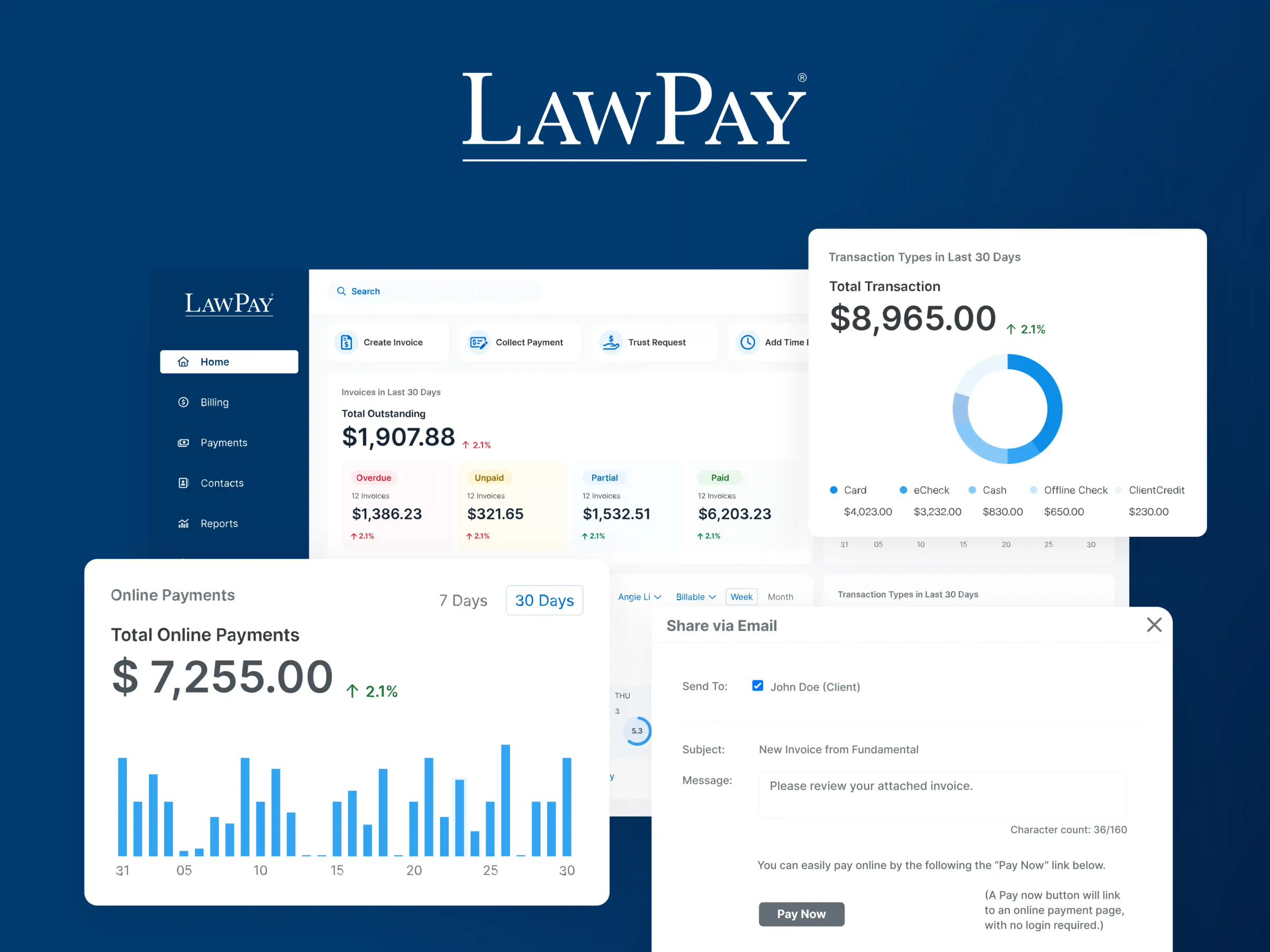Today’s customers are more tech-savvy and connected than ever, especially when it comes to making payments. Mobile payments have gone from a high-tech option for a niche group of customers to a common payment method for almost everything. The rising usage of services like digital wallets, mobile credit card payments, and in-app payments is changing customer expectations and behaviors in a big way.
In fact, many customers expect and even prefer using services and merchants that accept mobile payments. The number of people who rely on mobile payments is only expected to increase as solutions get more convenient, sophisticated, and secure.
It’s also worth noting that this shift in customer expectations isn’t limited to consumer goods. Businesses across all industries are future-proofing operations by updating their payment systems with easier ways to pay. So, it’s not surprising that putting convenient, connected payment options at clients’ fingertips is increasingly vital for law firms looking to create a modern, streamlined customer experience.
Schedule a demo to see what LawPay can offer your firm.
Book Now
However, that can be easier said than done. These days, there are dozens of mobile payment options out there. Added to that, law firms must ensure that any mobile credit card payment method they implement is fully compliant with legal standards. In short, many law firms simply don’t know where to start. If you’re considering accepting mobile payments, it’s essential to have a full understanding of the landscape of mobile payment technology.
What Are Mobile Payments?
While the term “mobile payment” is thrown around everywhere these days, it’s not often clearly defined. This can be especially confusing when it comes to practically implementing it in your business. So, what exactly are we talking about when we say mobile payments?
Put simply, a mobile payment refers to the ability to pay for a service via a smartphone, tablet, or any other mobile device. Mobile payment technology encompasses both being able to make and receive a contactless payment. In other words, it refers not to one specific technology but to the whole contactless payment ecosystem, from in-person attachments on phones that accept credit card payments to remote payment options like apps or websites. These technologies allow customers to make secure payments without physical credit cards, cash, or checks.
The Various Types of Mobile Payments Explained
With so many types of mobile payment methods out there, knowing which one to offer clients can be overwhelming. In truth, there isn’t necessarily one right answer. Different mobile payment options appeal to different customer preferences. The good news is that many modern legal payment solutions allow you to use multiple methods of payment within a unified and secure system. That means you can offer more flexibility and payment options without adding backend accounting complexity.
Before going into the specific benefits of a mobile payment solution, let's go through a high-level rundown of the most common types of mobile payment in use today.
Remote
Typically, when most people picture online shopping—buying an item from a website, ordering tickets online, etc.—they are thinking of remote payments. This payment method allows a client to pay from anywhere via a web browser, in an app, via a third-party processor, or payment link.
Web Browser or In-App Internet-based payments are probably the most common payment method and one that clients are likely to be familiar with. For a browser-based payment, a client navigates to a specific web page on either an Android or iPhone phone. Conversely, a law firm could offer clients a dedicated app, such as the LawPay mobile app, to easily make payments for retainers and legal fees. To make a credit card mobile payment, a person would then either enter their credit card information manually or use the information stored in a digital wallet or third-party service (mentioned in more detail below). Many of these options do not require a user to sign up or make an account, which can be helpful for less tech-savvy users or those who simply don’t want another account on their phone.
Third-Party Payment Processor Popular third-party payment apps like PayPal, Venmo, or Due (to name a few) are also a common way to accept credit card payments on a smartphone. Many of these services allow invoices to be sent directly to the customer where they can make the payment through the processor’s app or website. While most of these options require a user to make an account, they also provide an added layer of convenience and security.
Payment Link A payment link is simply a URL or other clickable button that a client can interact with to go directly to a payment page, get bank details, or view an invoice. While very similar to other remote options, a payment link is unique because of the variety of ways it can be delivered to customers. For instance, a link could be sent over SMS text (handy for older or less tech-savvy clients), email, messaging app, or even social media. Additionally, many links can be customized on the backend to take clients right to the relevant billing information.
In-Person or Point-of-Sale Solutions
Electronic mobile payments are not limited to web pages and apps, however. There are now many mobile point-of-sale solutions for use in-office. It’s likely that you’ve encountered these devices before. It’s not at all uncommon to see a card reader attached to a mobile phone or tablet. That said, not all point-of-sale solutions require additional hardware. There are a few ways that a law firm can handle credit card mobile payments in a physical location.
NFC Payments NFC stands for “near-field communication” and is a method for making secure payments with a mobile device. Without diving too heavily into the details, this technology can transmit data over short distances from a client’s phone to an NFC-enabled device using a specific radio frequency. The extremely short range the devices are from each other (usually just a few inches) and the near-instant speed at which the data is sent makes it harder for thieves to intercept. As an added layer of security, NFC technology encrypts all transaction data.
Soundwave Payments This is a relatively new technology and one that is gaining popularity since it doesn’t require an investment in special hardware to use. Users can initiate a payment from their phone (with or without a WiFi connection). The terminal then uses the phone’s speaker and microphone to translate and authorize the transaction data back to the customer. Soundwave payments are made for maximum flexibility and work with a wide variety of POS terminals, banking apps, and other mobile wallets.
MST Payments Magnetic Secure Transmission (MST) works by mimicking the magnetic stripe found on most credit cards. This is advantageous for locations that already have a traditional card reader, as MST gives clients more ways to pay while still allowing businesses to use their existing payment systems and hardware.
Credit Card Scanners If you don’t want to invest in physical hardware at all, some modern payment apps also support a built-in credit card scanner that requires nothing more than a phone to use. The person handling the billing uses a smartphone camera and a connected app to quickly scan credit card information in a matter of seconds. This makes the process easier and more secure for clients, as they don’t have to manually enter any card information and the card never has to physically leave their hand.
In-Person and Remote
There are also some mobile payment options that can be used in either a physical location or remotely. These options enable a unified customer experience no matter where your clients are. Below are a few of the most common ways to accept credit card payments on a smartphone from any location.
QR Codes Quick Response or QR codes are pictures generated from black and white boxes that open a specific link or app when scanned by a smartphone or tablet’s camera. QR codes are usually used within an app or require a specific app to use. That said, paying by QR code has become much more ubiquitous and easier to do in recent years. Apple iPhones have started to support native QR support in their camera, and recent updates to some Android phones are following suit.
Mobile Wallets Mobile wallets aim to do exactly what the name implies, letting customers securely store credit cards, loyalty cards, and other payment information in a single app. Mobile wallets like Apple Pay, Google Pay, and Samsung Pay are gaining popularity since they allow shoppers to make purchases without lugging their physical wallets around. Better yet, an increasing number of merchants and services support mobile wallet integrations, making payments easier for both in-store and online purchases. In-store, mobile wallet solutions are typically supported by a variety of the payment methods mentioned above, from NFT and soundwave transactions to QR codes, and more.
The Benefits of Accepting Mobile Payments at Your Law Firm
Now that you have a better idea of the various methods you can use to accept mobile credit card payments, you may be asking: why should you?
The better question you should be asking instead is: why wouldn’t you? According to the Pew Research Center, nearly 85% of Americans own a smartphone. And an increasing number of smartphone users are using them to make and accept payments. As more businesses and aspects of daily life go digital, today’s customers expect effortless and convenient payment options. There are also numerous benefits that come from offering mobile payment at your law firm.
More Customer Convenience
Meeting modern customer expectations isn’t only about which payment options you provide but how many. As people get more comfortable with technology, they have stronger preferences for how they want to pay. Having a variety of ways to accept payments lets your clients choose an option that is most convenient to them. On top of that, many mobile payment options are simply quicker and less cumbersome, creating a better overall customer experience.
Reduced Expenses
The speed of mobile payment isn’t just a benefit to the customer, it also significantly streamlines your law firm’s financial operations. Faster processing of payments cuts down on time spent organizing paperwork and manually entering accounting data, freeing up time to work on more important tasks. Beyond that, giving clients easier and more flexible ways to pay can decrease time spent chasing down payments or following up on unpaid invoices.
Increased Security
Mobile payment technology adds an extra layer of security and encryption to every transaction, helping keep both your firm’s and your client’s information safe. Using the right legal payment processing solution also ensures your payments always meet ABA and IOLTA compliance standards.
Better Software Integrations
Digital payments also allow for better end-to-end process integration with other pieces of mission critical software. LawPay currently supports integration with many of the industry’s most popular practice management solutions, giving you modern payments with more flexibility.
How Your Law Firm Can Start Accepting Mobile Payments
Luckily, setting up mobile payment at your law firm is a relatively simple process.
Find Payment Providers Who Understand Your Needs For law firms, finding technology partners who provide flexible options for remote or in-office payment is only one piece of the picture. It’s also equally important to collaborate with solution providers who understand the ins and outs of legal payments and can integrate with your existing software and processes. Specialized software is also able to separate funds for operating and trust bank accounts in order to meet IOLTA compliance.
Ensure Payment Equipment and Solution is Secure No matter what solution you choose, it’s important to ensure that your payments are secure. For instance, if you buy a card reader to accept credit card payments on a phone, make sure to buy an EMV-compliant device. For other mobile solutions, look for vendors that rely on encryption and regularly update their products to meet the latest cybersecurity standards.
Once You’re Set Up—Make Sure Clients Know About It Even if your firm offers the most cutting-edge, convenient payment options, it won’t matter if your clients don’t know they exist. Invest some resources into educating your clients on the various ways you accept mobile payment.
Choosing the Right Mobile Payment Partner
While theoretically, most mobile payment solutions could work with almost any accounting system, it goes without saying that the process of setting up mobile payments at a typical retailer vs. a law firm is very different. Finding the right payment partner is crucial for law firms who want to add digital payments without disrupting day-to-day operations or increasing compliance risk.
When searching for the right payment partner, look for a technology provider that has ample experience in the legal world, such as LawPay. By partnering with a payment processor that is purpose-built for law, you also gain access to specific features that help law firms accept, process, and integrate payments.
To learn more about how LawPay is taking the work out of getting paid, schedule a demo today.
Schedule a demo to see what LawPay can offer your firm.
Book Now
About the author

The LawPay Team
